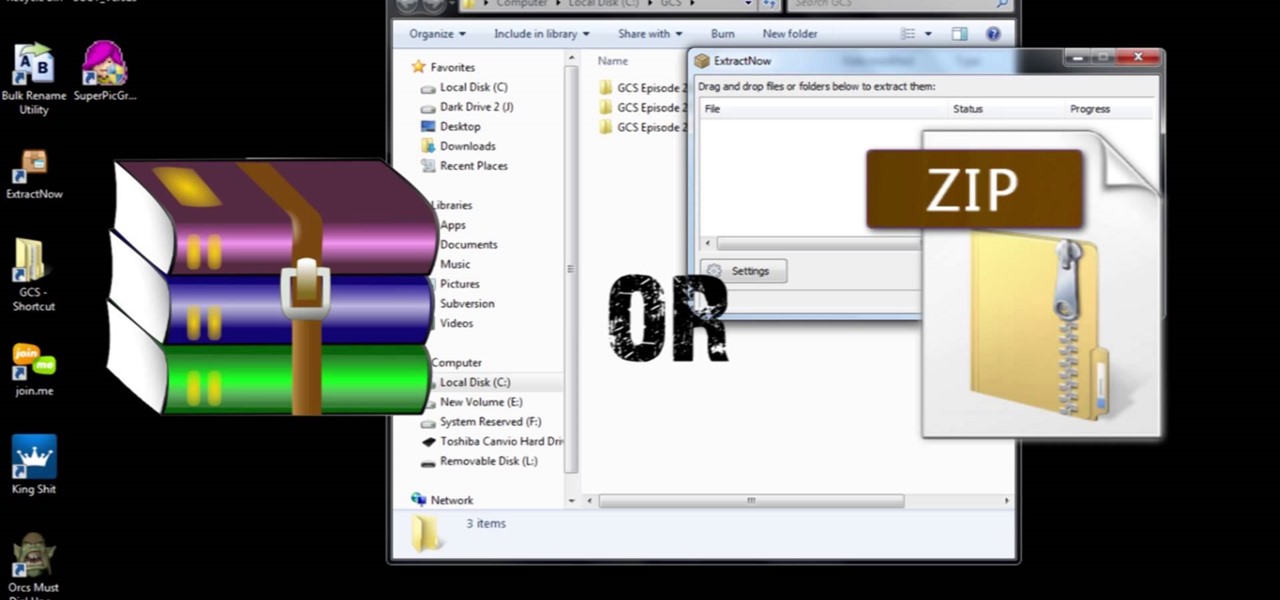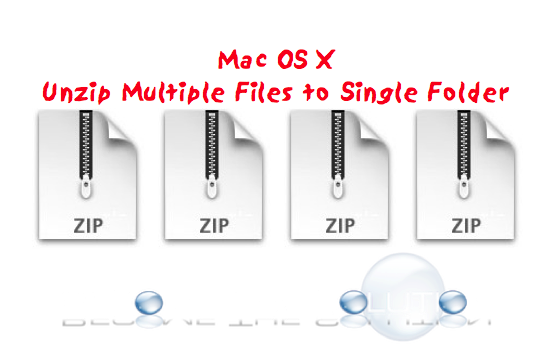Click ' Select zip file to extract ' to open the file chooser. Drag and drop the zip file directly onto the unzip files panel. It will start the file extraction and list the contents of the zip file once complete. Click 'Save' on the individual files to save file to your local drive. OPTIONAL: Click blue 'Preview' button to open. To create a split Zip file, you would need to: Create a new Zip file or open an existing one in WinZip. Click the Tools tab and click Multi-Part Zip File. Type the name for your split Zip file and choose a target folder. Note: The name must be different from the name of the open Zip file. Click OK to create the Split Zip file. Mac X Open Multiple Zip Files To One Folder Unzip With OSX you can run a simple terminal command and extract all the files into the same directory without the need of a third party application. When u want to extract multiple files from different folders, then this video will makes u to extract in less than a minute. Just some bugs in your shell script file. I fixed it as following code (you can use bash -x to debug & customize more if need). Bash -x test.sh Notes: To run same code in Windows & MacOS I think you should use Linux WSL in Windows or replace unzip by 7z in the following code.
When you come across split ZIP files that look like sequential part numbers, before extracting files out of the archive, you first need to join the split files together into a single, complete, ZIP file. A split ZIP file could look like this, for instance: 691-5088-A.zip_.001 NOTE: Just so it's clear to everybody, this article talks about ZIP but it obviously works on ANY type of file. It doesn't matter if it's a ZIP or DMG or TEXT or any kind of file, that is irrelevant. It's just a split file. It has nothing specific to do with ZIP. You can think of 'ZIP' here in this article as 'A FILE'. e.g. ASD_ssps_004-0303-A.001.dmg + ASD_ssps_004-0303-A.002.dmg will become ASD_ssps_004-0303-A.dmg Under WindowsOpen a command prompt and navigate to the folder containing all the ZIP part files. Once you're under that folder, adapt the following command (here based on the part files listed in example above) to your situation: copy /B 691-5088-A.zip_.* 691-5088-A.zip NOTE: Remember that '.zip' is only an example here. If your file is, e.g. a DMG, then it should end with '.dmg', not '.zip'. What this does is to create a combined file (copy) from all the ZIP parts and save it as 691-5088-A.zip which you can then expand normally. Under Mac OS X or LinuxOpen a Terminal window and navigate to the folder containing all the ZIP part files. Once you're under that folder, adapt the following command (here based on the part files listed in example above) to your situation: cat 691-5088-A.zip_.* > 691-5088-A.zip NOTE: Remember that '.zip' is only an example here. If your file is, e.g. a DMG, then it should end with '.dmg', not '.zip'. What this does is to combine (cat) all the files into a single file named 691-5088-A.zip which you can then expand normally. Under classic Mac OS (9, 8 or 7)Use ChunkJoiner. Select all the .001, .002, .003, etc ZIP part files all at once then drag and drop the files selection onto the ChunkJoiner app icon and save the recombined output a file name. If dragging and dropping files onto the app icon doesn't work, rebuild the desktop once before using this app so that the Finder knows that this app accepts all file types. That's it :) |
General Information About ZIP Files
Make Zip File On Mac
ZIP files are compressed archives that group together one or more files into a single file, compressing the files (making them smaller) that are contained inside. The ZIP file format is very popular for efficiently storing and transferring groups of files in a variety of business and personal applications.
The ZIP file format dates to the late 1980s when it received heavy use in pre-internet-era Bulletin Board Systems, or BBSes. In this era, file transfers occurred using MODEMs and transfer speeds were very limited. Using ZIP compression regularly saved minutes or even hours off of file transfers. It also allowed for multiple files and folders to be grouped together ('zipped') and transferred as a single ZIP file. Once received, the ZIP file would then be opened and its contents decompressed ('unzipped') onto a user's computer.
Today, the ZIP file format remains in heavy use in the internet and in the cloud, with billions of such files in circulation. In the cloud, ZIP files are commonly found as both Gmail attachments, as well as files stored in Google Drive or other cloud-based storage systems such as Dropbox and Microsoft OneDrive.
In addition to compression, ZIP files are archives that can group together multiple files and folders. When this is done, the path and folder information of the file tree is preserved inside the ZIP file. This makes the ZIP file format convenient for sharing and distributing groups of files.
Examples of ZIP File Uses
ZIP files are common across a variety of business areas, including industries ranging from medical, insurance, legal, mortgage, banking and financial, scientific, equities and trading, SEO (Search Engine Optimization), and education industries.
Here are some specified real-world examples of actual usage of ZIP files:

- A car insurance agent ZIPs and emails information related to a person's health insurance, homeowner's insurance, auto insurance, or life insurance policy.
- A real estate agent scans and ZIPs a sales contract and sends it to a mortgage broker for a home loan when buying a home.
- An attorney or lawyer for a law firm ZIPs together a set of related legal documents such as a will, trust, claim, or other estate planning documents and shares them with their client.
- A university student ZIPs a homework assignment and related files and sends it to their instructor or professor in an online degree program.
- A tax accountant ZIPs and emails a copy of a person's federal and state tax returns for review before filing with the IRS.


ZIP files can contain multiple files of different types. Common files that can be included in a ZIP archive include PDFs, images, videos, and Microsoft Office documents including Microsoft Word, Microsoft Excel, and Microsoft PowerPoint (*.DOCX, *.XLSX, *.PPTX file formats).
Creating and Opening ZIP Files
Unzip Software For Mac
ZIP Extractor and most modern operating systems have built-in functionality to create ZIP files.
- On Windows or PC, to create a ZIP file, right-click files in Windows Explorer and select “Send to -> Compressed (zipped) Folder.”
- On a Mac running Mac OS, create a ZIP file by right-clicking files in Finder and select 'Compress [name_of_file].”
- On a Chromebook running Chrome OS, choose one more files in the Files app and then select “Zip selection.”
- In ZIP Extractor, click 'Create New ZIP' and from there you can add files and folders to be compressed, including files from Google Drive. You can also drag-and-drop files and folders onto the main screen to ZIP them.
- In your internet browser, you can also use the URL shortcut zip.new to go directly to the ZIP Extractor 'Create New ZIP' screen.
On Windows, Mac, or Chrome OS, a ZIP file can be extracted (decompressed) by double-clicking it. Then, the individual files will be unzipped into a new directory and available to preview, edit, print, etc.
ZIP Extractor provides the same decompression functionality that standard operating systems provide, except that ZIP Extractor supports many more formats than the basic built-in functionality of most ZIP programs. Most importantly, ZIP Extractor is designed bottom-up to work directly in the cloud. Because there is no built-in ability to unzip ZIP files in Google Drive or Gmail, ZIP Extractor is a third-party application that provides this functionality.

Encryption and Password Protection
The ZIP file format provides support for basic password-protected ZIP files. More recently, the ZIP format was enhanced with the ability to create files with strong encryption, using AES (Advanced Encryption Standard). This 'strong encryption' approach is much more secure than the original version, but it is less compatible because Windows and Mac cannot open them. ZIP files using 'strong encryption' require ZIP Extractor, WinZip, or other more advanced program to open.
Other archive formats, including RAR and 7-Zip, also allow passwords. These formats have a special ability to also encrypt the names of the files contained in the archive file (using the supplied password), in addition to file content.
ZIP Extractor has full support for opening ZIP, RAR, and 7-Zip files with all types of passwords and encryption formats. It can also create ZIP files with both the standard encryption (compatible with Windows and Mac) or 'strong encryption' (requiring ZIP Extractor or WinZip to open).